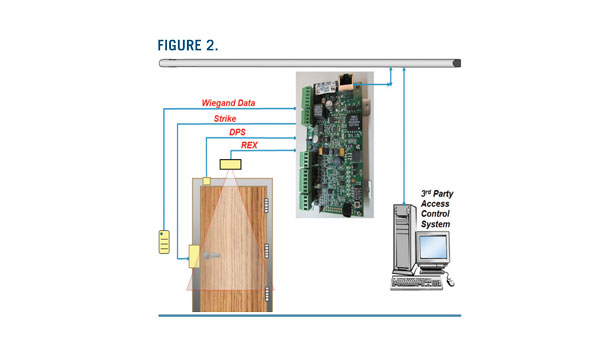He was a seasoned security professional, certified by ASIS International. As he and I were discussing the side effects of government regulations I asked: “Why don’t we see door knobs in commercial buildings anymore?” His response: “I think it has something to do with the Americans with Disabilities Act.”
“Sir, you are correct. And the side effect of that 1990 law is that most cylindrical locks now have a very large ‘rose’ that contains an additional spring in order to bring the lever back to its upright and locked position.” By the look on his face, I knew we had a disconnect. His security expertise fell two-and-three-quarters of an inch short when it came to locking hardware knowledge.
Ask most security system integrators, door and hardware professionals, consultants, contractors and end users: “What’s the most challenging part of an access control project?” They will tell you it is the coordination of the electrified door hardware connected to the electronic access control system.
Education, Communications & Coordination
How do we correct this “disconnection” between electronic security professionals and door and hardware professionals? My answer is: education, communication and coordination. Michael Webb of Phoenix-based HES tells a story of when he first started selling electric strikes for access control applications. The security systems provider told him to take it to the locksmith because it — the lock strike — was part of the door. The locksmith told him to take it to the systems provider because it had wires coming out of it. Sounds like a catch-22 situation.
Take a close look at a typical electronic access control panel (Figure 1, above). What do you see? You see “connections” points:
1) Connect the card reader here.
2) Connect the door position switch here.
3) Connect the request-to-exit sensor here.
4) Connect the “by others” here — the what? By others?
I’ll comment on “by others” a little later, but first I have a simple question: What is your electronic access control system controlling? Here’s a hint:
Present your card to the reader and if authorized, you can now access the facility through the door — the door and door hardware “by others” (Figure 2).
My opinion is: You own the door! The moment you add a card access system to control the door, in the eyes of your customer, you own it. Anything that goes wrong with that opening is your problem. And your problems are only going to increase with more and more technology moving from “around-the-door” to “on-the-door.” With that fact in mind, it’s imperative that electronic savvy professionals understand the language, purpose and function of the door and door hardware.
The Fading Legacy of ‘Around the Door’
Words from an old Bob Dylan song go, “The times they are a-changing.” Well, the world of electronic door hardware is changing, too. For many years, you installed individual or discrete components around the door and connected those components to the access control panel (Figure 3).
But more and more projects are using totally integrated locksets that contain all of those discrete components — the card reader, door position switch, request-to-exit device — contained within a grade 1 electrified lockset (Figure 4).
This requires the security systems integrator to have at least a basic understanding of door locking hardware or at least the three most common types of locks (left to right, Figure 5): cylindrical, mortise and rim exit.
While there are other types, these three are what your installers and service technicians will encounter most often when it comes to a totally integrated unit.
Wire, Wireless or Less Wires
Another big change is the Less Wire integrated locksets being introduced by numerous manufacturers. These locksets install on the door and communicate wirelessly to the access control panel, thus eliminating the need for wire from the door to the panel (Figure 6, below).
A few manufacturers have taken technology to the level of IP locksets, thus eliminating the access control panel and wires from the door entirely. This allows you to provide access controlled doors that ride on the customer’s existing network. Your access controlled door now just becomes another device on the network, communicating via a wireless access point or WAP (Figure 7).
By Others?
Now let’s talk about that phrase “by others.” How many times have you seen this in a specification for one of your projects?
From Division 28 – Electronic Safety and Security: “Electric door hardware, sensors, egress devices, and associated power supplies for card reader doors shall be furnished and installed by OTHERS.”
From Division 08 – Openings – Door Schedule:
GROUP 206 - Single door with access control
1 each Electric Hinge
1 each Electric Lockset fail-secure fail-secure
Function: Latchbolt by lever inside or key outside. Operating inside lever shunts the door position switch for request to exit. Outside lever rigid at all times unless unlocked electrically. Power off locks outside lever.
1 each Closer
1 each Power Supply
1 each Door Position Switch
1 each Card Reader by Others.
Connection by Division 26. (Electrical)
Operational Description: Door normally closed and locked. Free egress allowed at all times. Outside access by card reader, which will shunt the alarm and unlock outside lever.
As an access control professional, you must take ownership of all your electronically secured openings. In other words, as I have already stated, you own the door, whether you want to acknowledge it or not. When an employee presents their card to your reader on their door and that lock does not unlock to grant them access through that door, whether it is a programming error, a product failure error or a door out of alignment, nine times out of 10 you’re going to get the service call.
“Sorry, Mr. Customer, it’s not my problem. The problem belongs to ‘by others.’” How well does that usually work out? What it usually results in is a “pointer meeting” where “others” are all pointing their fingers at you, the security systems integrator.
A simple rule for avoiding pointer meetings is to make sure you get a formal introduction to “the others” and hold a coordination meeting. Define, in writing and with shop drawings, exactly who is responsible for what. If you do this, you will be above the pointer meeting that results in fighting over “6 inches of no-man’s land.”
6 Inches of No-Man’s Land
When I speak of 6 inches of no-man’s land, I’m referring to the disconnect between the trades as to where the cable coming from the door to the electronics above the ceiling stops — and where the cable coming from the access control system’s door controller stops. They always seem to stop 6 inches short of each other. And the pointer-meeting begins.
So one way or another, you’re going to have a meeting; your project will be a lot more profitable if you conduct a coordination meeting up front and iron out the details of that 6-inch vacuum. Who is going to connect and terminate what? Who is supplying “the others’” stuff?
Many systems integrators seem to dismiss the mechanical function of the door. They are so concerned with installing a card reader on the wall, a door position switch in the door frame, and a PIR REX above the door, but let others install an electric strike, mag lock or electrified lock. But you can add all of the electronic components you want around the door. If that door doesn’t close and latch to secure that opening, all your cards and card readers aren’t going to amount to much or provide any level of security.
Becoming Door & Hardware Savvy
If you want your projects to run smoothly and profitably, you should invest time in education and training on doors and door hardware. Some very good resources are readily available. Start by joining the Door and Hardware Institute (DHI). This organization has some excellent online and classroom training programs. Another organization you should investigate is the American Locksmith of America (ALOA). Also, ASSA ABLOY Americas University has more than 50 free online courses covering electrified hardware, doors, frames, mechanical locksets, and codes and standards, to name a few.
On a positive note, I have a suggestion for an area where I feel systems integrators could offer an increased service to customers and generate additional revenue for their companies. If you asked a typical security systems installer to give you the definition of an ELR, it would be “end of line resistor.” If you asked a contract hardware professional, his definition would be “electric latch retraction.” (below left). This acronym is but one example of why you need to invest in cross training and education.
And if you gain knowledge and expertise on the subject of electric latch retraction, you could open up additional revenue opportunities for your company.
Electric latch retraction, also known as ELR, is a means of electronically retracting — either momentarily or continuously — the latchbolt or bolts usually of an exit device.
Here are some common applications and most can or should be integrated into your access control system.
As we know, most buildings have fire walls preventing fire from traveling throughout a building. All fire walls with openings must have fire-rated doors and hardware which must be auto latching to create a solid barrier that prevents the spread of fire. Since these openings must be self-closing and latching, manual dogging is not allowed.
Because electric latch retraction devices are hooked up to the fire alarm system, they eliminate these concerns by creating a push/pull opening of the fire-rated doors. Once the fire system has been activated, the electric latch retraction devices automatically release the latchbolts, allowing the hardware to secure the openings as required by law and life safety concerns.
Handicap entrances have become part of the law in most public buildings today. With electric latch retraction exit devices used in conjunction with a low-energy operator and a means of activation, a difficult problem is resolved. Using handicap push pads (above left) on both sides of an opening as a means of activation, an individual is able to open a door by simply pushing on either pad; this initiates the electric latch retractions followed by the door operator, which opens the door allowing free passage.
Schools must be kept safe and secure so children are not endangered. What is the best way to do this? Electric latch retraction exit devices, of course. It is 7 a.m. Monday morning and the bank of doors in the front of the school need to be unlocked to welcome the children.
What would be simpler than having electric latch retraction devices on all the doors connected to a time zone in the access system, so that at 7 a.m. all the doors unlock at the same moment and then automatically relock at 8 a.m. at the beginning of the school day? As an additional precaution, the use of door position switches or latch-bolt monitoring strikes can allow an individual to verify the security of the doors from a remote location. The process can be repeated at the end of the school day and when the school closes for the evening.
While sitting in a quiet theater or library, did you ever notice how annoying it can be to hear someone exiting the room, when all you hear is the push rail slamming into the mounting rail to retract the latchbolts?
With some electric latch retraction exit devices, when activated, not only are the latchbolts held in the retracted position, but the push rail is also. This creates a solid push bar without any moving parts, making it silent. This is just one more benefit in the world of electric latch retraction exit devices.
The playoff basketball game has just ended with a huge victory in the high school gym. The students are thrilled and adrenaline is flowing. As the students exit the gym, the doors will be thrown open, probably quite roughly. With electric latch retraction devices, the latchbolts are held in the retracted position, eliminating moving parts within the device and allowing for free flow of traffic through the doors, no matter how ill-used.
Even though most may think pushing on the cross bar is the simplest way of exiting, others take these opportunities to test the quality of the doors and hardware. The simplest way for the hardware to pass these tests is by eliminating any resistance. With electric latch retraction devices, the doors become push/pull and no matter how great the basketball victory, the hardware will endure for many more years.


































